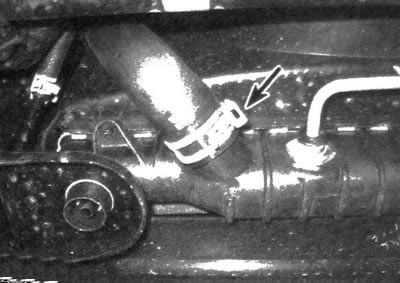Warning 1: Before starting this procedure, you must wait until the engine has completely cooled down.
Warning 2: do not allow antifreeze to come into contact with the skin of people or animals, as well as automobile and other paint surfaces. The area on which antifreeze has come into contact should be immediately washed with running water. Keep stored antifreeze away from children or pets, who may be attracted by its sweet smell. Swallowing even small amounts of antifreeze can be fatal. Wipe up spilled antifreeze from the garage floor immediately. Keep antifreeze canisters tightly sealed and repair any leaks in the cooling system immediately. Dispose of used coolant in accordance with environmental standards and requirements. Do not drain coolant onto the ground or down a drain. Antifreeze is a flammable liquid under certain conditions - see precautions on the container label.
Note: Non-toxic antifreeze is now available in many stores, but coolant containing this type of antifreeze must also be safely disposed of in an environmentally responsible manner.
Caution: Do not mix green ethylene glycol antifreeze with orange antifreeze «DEX-COOL», which does not have silicate components, since this reduces the efficiency of the latter, which is intended for operation over a mileage of 160,000 km (or 5 years).
Draining liquid
1. The cooling system periodically needs to be drained, washed and filled with a new antifreeze solution. This is necessary to prevent the formation and accumulation of corrosive deposits in the system, the presence of which leads to reduced performance and engine damage.
2. Apply the parking brake and chock the wheels.
Warning: if the car has just been in use. Proceed with this procedure after several hours, when the engine has completely cooled down.
3. Place a large container under the radiator drain fitting to catch the draining fluid. Loosen the clamp, slide the lower radiator hose back and drain the fluid into a container (see illustration). Remove the radiator cap.

30.3. The liquid from the cooling system on the described vehicles is drained when the lower hose is disconnected from the radiator
4. After draining the coolant, inspect the radiator and heater hoses, as well as their clamps (see subsection 14).
5. Replace damaged hoses and clamps. Connect the lower hose to the radiator, as well as the bleeder hose to the throttle body.
Flushing
6. Fill the system with clean water as described in this subsection from point 12 in the subtitle «Filling».
7. Start the engine and wait until it warms up to normal operating temperature, then press the accelerator pedal several times.
8. Stop the engine, wait until it cools down and drain the water as described above.
9. Perform the operation described in paragraphs 6-8 until the drained water becomes clear.
10. If the radiator is heavily soiled or clogged, remove it (see chapter 3) and take it to a workshop for cleaning or repair.
11. Deposits covering the walls of the radiator are removed using special means. Follow the instructions for using the cleaner.
Note: if the system is regularly maintained and refilled with an aqueous solution of antifreeze of the appropriate type, then the use of special chemicals is not required when flushing.
Filling
12. Connect the lower hose to the radiator and install the clamp. Disconnect the bleeder hose from the throttle body.
13. Turn the heater temperature regulator to the maximum position.
14. Gradually fill the radiator with new fluid of the appropriate type. Install the radiator cap.
15. Add fluid to the expansion tank until the level reaches the FULL COLD mark, then install the cap.
16. Connect a hose to the throttle block to bleed the system.
17. Start and warm up the engine at 2000 rpm to operating temperature. After that, leave it idling for three minutes.
18. Stop the engine and wait until it cools down.
19. After the engine has cooled, remove the radiator cap and add coolant if necessary. Install the radiator cap, then add fluid to the expansion tank if necessary.
20. Check for coolant leaks.
